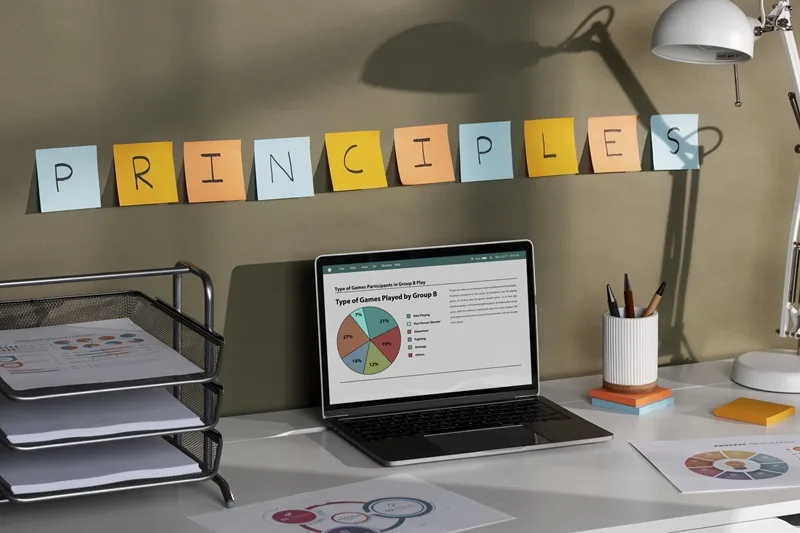Introduction to Git Workflow
Git is a powerful version control system that has become an essential tool for software development teams. However, simply using Git without a well-defined workflow can lead to chaos, confusion, and inefficient collaboration. Establishing a standardized Git workflow is crucial for maintaining a organized and efficient development process. In this comprehensive guide, we will explore the git workflow best practices that can streamline collaboration and improve the overall software development lifecycle. We’ll delve into the importance of Git workflow, common challenges, key components, and strategies for choosing the right workflow for your team. Additionally, we’ll cover practical steps for implementing Git workflow best practices using GitHub, as well as tools and resources to help you master this essential skill.
What is the Correct Workflow of Git?
The correct Git workflow is not a one-size-fits-all solution, as it can vary depending on the size, complexity, and specific needs of your project and team. However, there are several generally accepted best practices that can serve as a foundation for an effective Git workflow. Transitioning from the recognition of individualized workflows to foundational practices, maintain a clear and organized branching structure, with dedicated branches for features, bug fixes, and releases. Furthermore, write clear, concise, and informative commit messages that describe the changes made in each commit.
Moreover, use pull requests for code review, collaboration, and merging changes into the main codebase. Additionally, automate the build, test, and deployment process to ensure a smooth and reliable workflow. Lastly, regularly review and optimize your Git workflow to address any bottlenecks or inefficiencies. By adhering to these best practices, teams can create a streamlined and collaborative Git workflow that supports the software development process seamlessly.
Understanding the Importance of Git Workflow Best Practices
Implementing a well-designed Git workflow is crucial for several reasons. Firstly, it fosters improved collaboration among team members, reducing conflicts and ensuring a consistent development process. Also,, a proper Git workflow can also increase productivity by automating repetitive tasks and streamlining the development lifecycle. Moreover, it contributes to better code quality by facilitating rigorous code review, testing, and deployment processes. Thereby minimizing the risk of bugs or regressions. Additionally, a well-defined Git workflow reduces complexity in the development process. This makes it easier for new team members to onboard and understand the codebase. Furthermore, it enhances traceability and accountability by providing a clear record of changes, contributors, and decision rationale, improving transparency. By comprehensively understanding the importance of Git workflow best practices, teams can make informed decisions and implement strategies aligned with their specific needs and goals.
Common Challenges in Collaboration without a Proper Git Workflow
Collaborating on a software project without a proper Git workflow can lead to several common challenges. Firstly, without a clear branching strategy, team members may encounter frequent merge conflicts when trying to integrate their changes. This can lead to time-consuming resolution processes. Aditonally, without a centralized workflow, it becomes difficult to track the progress of different tasks. Also, it’s hard to understand the current state of the codebase, and identify bottlenecks. Moreover, inconsistent coding practices can arise without agreed-upon standards for commit messages and branch naming. Similarly to other Git-related practices, making the codebase disorganized and difficult to maintain.
Furthermore, difficulty onboarding new team members can occur without a well-documented and standardized Git workflow. This can lead to a time-consuming and frustrating process. Lastly, reduced accountability may result from a lack of clear record of changes and the ability to track who made what modifications. This makes it challenging to identify and address issues and maintain accountability within the team. Addressing these challenges through the implementation of a robust Git workflow can significantly improve the overall collaboration and efficiency of a software development team.
Key Components of an Effective Git Workflow
An effective Git workflow typically consists of the following key components:
- Branching Strategy. A well-defined branching strategy that outlines the purpose and naming conventions for different types of branches (e.g., feature, hotfix, release).
- Commit Guidelines. Established guidelines for writing clear, concise, and informative commit messages that describe the changes made in each commit.
- Code Review Process. A structured code review process, often facilitated through pull requests, to ensure code quality and maintain consistency.
- Continuous Integration and Deployment. Automated build, test, and deployment processes to ensure a reliable and efficient development pipeline.
- Monitoring and Optimization. Regular review and optimization of the Git workflow to address any bottlenecks or inefficiencies and continuously improve the development process.
By implementing these key components, teams can create a Git workflow that supports their specific needs and helps them achieve their software development goals.
What is Git Flow Strategy?
The Git Flow strategy, developed by Vincent Driessen, is a popular branching model and workflow that provides a structured approach to managing the different stages of a software project’s lifecycle using Git. Transitioning from the introduction of the Git Flow strategy to its main components, the strategy comprises several key branches. Firstly, the Master Branch represents the production-ready codebase. Meanwhile the Develop Branch serves as the primary branch for integrating new features and bug fixes.
Additionally, Feature Branches are created for developing new features and merged back into the develop branch.Meanwhile Release Branches are used for preparing new releases, eventually merged into both the master and develop branches. Furthermore, Hotfix Branches are created to quickly address critical bugs in the production environment and merged into both the master and develop branches. By following the Git Flow strategy, teams can maintain a clear and organized codebase. Also with a well-defined process for managing different stages of the software development lifecycle.

Choosing the Right Git Workflow for Your Team
Selecting the right Git workflow for your team depends on various factors. This may include the size of your team, the complexity of your project, the development lifecycle, and the level of collaboration required. Common Git workflow options include the Centralized Workflow, Feature Branch Workflow, Gitflow Workflow, and GitHub Flow.
The Centralized Workflow is a simple approach suitable for small teams with minimal collaboration. Here, all changes are committed to a central repository. In contrast, the Feature Branch Workflow involves developing each new feature in a dedicated branch, merging it into the main branch after review. Also, is suitable for medium-sized teams. The Gitflow Workflow, as discussed earlier, is well-suited for larger, more complex projects with a structured development lifecycle. Additionally, the GitHub Flow is a lightweight workflow focusing on continuous deployment. Here, changes are merged directly into the main branch after review, suitable for agile development teams. When choosing a Git workflow, it is essential to consider your team’s specific needs, project complexity, and collaboration requirements. Evaluating the pros and cons of each workflow option is crucial to selecting the one that best aligns with your team’s goals and development process.
Implementing Git Workflow Best Practices Using GitHub
GitHub is a popular platform for hosting and collaborating on Git repositories, and it offers several features that can help teams implement Git workflow best practices:
- Branching and Merging: GitHub’s branching and merging capabilities allow teams to create, manage, and merge branches in a streamlined manner.
- Pull Requests: GitHub’s pull request feature facilitates code review, collaboration, and the merging of changes into the main codebase.
- GitHub Actions: GitHub’s built-in continuous integration and deployment platform. GitHub Actions, can be used to automate the build, test, and deployment processes.
- Project Management: GitHub’s project management tools, such as issues and project boards, can be used to track and manage the development workflow.
- Integrations: GitHub integrates with a wide range of tools and services. This allows teams to customize and extend their Git workflow to meet their specific needs.
By leveraging GitHub’s features and capabilities, teams can effectively implement Git workflow best practices and streamline their software development process.
Git Workflow Best Practices for Branching and Merging
Maintaining a well-structured and organized branching strategy is crucial for an effective Git workflow. Here are some best practices for branching and merging:
- Branch Naming Conventions. Establish clear naming conventions for your branches, such as using prefixes (e.g., “feature/”, “bugfix/”, “hotfix/”) to indicate the purpose of the branch.
- Branch Protection Rules. Use branch protection rules to enforce code review, status checks, and other requirements before merging changes into the main branches.
- Merge Strategies. Adopt a consistent merge strategy, such as “no-fast-forward” or “squash”, to maintain a clean and linear commit history.
- Rebase vs. Merge. Understand when to use rebase and when to use merge, and establish guidelines for your team to ensure a consistent approach.
- Branch Cleanup. Regularly clean up merged and obsolete branches to keep the repository organized and easy to navigate.
By following these best practices, teams can maintain a well-structured and organized codebase, facilitating efficient collaboration and easier troubleshooting.
Using Pull Requests for Code Review and Collaboration
Pull requests are a powerful feature in Git workflows that enable collaborative code review and merging of changes. Transitioning from the introduction of pull requests to best practices for their effective use, here are some key recommendations. Firstly, provide clear pull request descriptions, explaining the changes’ purpose and relevant context concisely. Also, ensure that commit messages within the pull request are informative and align with your team’s guidelines.
Additionally, encourage comprehensive code review by team members, focusing on code quality, maintainability, and adherence to best practices. Furthermore, integrate automated checks, such as linting, testing, and security scans. This help ensure the quality and reliability of changes before merging. Finally, prioritize timely feedback and collaboration by responding promptly to comments and feedback on pull requests. This fosters an environment of collaboration and continuous improvement. By implementing these pull request best practices, teams can enhance code quality, promote collaboration, and streamline the overall development process.
Automating Git Workflow with Continuous Integration and Deployment
Automating the build, test, and deployment processes is a key component of an effective Git workflow. By leveraging continuous integration (CI) and continuous deployment (CD) tools, teams can streamline their development pipeline and ensure a reliable and efficient workflow. Here are some best practices for automating your Git workflow:
- Automated Builds. Set up automated build processes that trigger whenever changes are pushed to the repository, ensuring that the codebase is always in a buildable state.
- Comprehensive Testing. Implement a robust testing suite, including unit tests, integration tests, and end-to-end tests, to verify the integrity of the codebase.
- Deployment Automation. Automate the deployment process, from building and packaging the application to deploying it to the target environment.
- Environment Management. Maintain consistent and reproducible development, staging, and production environments to ensure a smooth deployment process.
- Monitoring and Alerting. Set up monitoring and alerting systems to quickly identify and address any issues that may arise during the build, test, or deployment stages.
By automating key aspects of the Git workflow, teams can reduce the risk of manual errors, improve the overall reliability of the development process, and free up time for more strategic and innovative work.
Monitoring and Optimizing Your Git Workflow
Regularly reviewing and optimizing your Git workflow is essential for maintaining its efficiency and effectiveness over time. Transitioning from the importance of regular reviews to best practices for monitoring and optimization, here are some key recommendations. Firstly, track key metrics, such as the number of merge conflicts, issue resolution time, and code review frequency. These help to identify areas for improvement. Moving from metric tracking to workflow audits, conduct periodic audits involving team members and stakeholders to gather feedback. And also to pinpoint potential bottlenecks or inefficiencies.
Additionally, adopt a mindset of continuous improvement by regularly reviewing and refining the Git workflow to address any issues and integrate new best practices. Furthermore, promote knowledge sharing among team members to facilitate a collaborative environment for continuous learning and improvement. Lastly, continuously evaluate and implement new tools and automation solutions to streamline and enhance the Git workflow. By actively monitoring and optimizing the Git workflow, teams can ensure that their development process remains efficient, effective, and aligned with the evolving needs of the project and the organization.
What is the Best Git Branch Strategy?
There is no single “best” Git branch strategy, as the optimal approach depends on the specific needs and characteristics of your project and team. However, some commonly used and effective Git branch strategies include:
- Git Flow: The Git Flow strategy, as discussed earlier, is a popular and well-structured branching model that is well-suited for larger, more complex projects with a defined development lifecycle.
- GitHub Flow: The GitHub Flow strategy is a lightweight and agile approach that focuses on continuous deployment. Here changes are being merged directly into the main branch after review.
- Trunk-Based Development: Trunk-based development is a simplified approach where all changes are committed directly to the main branch, with feature flags and short-lived feature branches used to manage complexity.
- Feature Branch Workflow: The feature branch workflow is a middle-ground approach where new features are developed in dedicated branches, which are then merged into the main branch after review.
When choosing a Git branch strategy, consider factors such as the size and complexity of your project, the development lifecycle, the level of collaboration required, and the overall team dynamics and preferences. Experiment with different strategies and continuously evaluate their effectiveness to find the best fit for your organization.
Git Workflow Best Practices for Remote Teams
Maintaining an effective Git workflow becomes even more crucial when teams are distributed and working remotely. Here are some best practices for remote teams:
- Clear Communication: Establish clear communication channels and protocols for discussing and coordinating changes, resolving conflicts, and providing feedback.
- Documented Processes: Ensure that your Git workflow and associated processes are well-documented and accessible to all team members, making it easier for remote team members to onboard and collaborate.
- Synchronous Code Review: Schedule regular synchronous code review sessions, either through video calls or screen-sharing, to foster collaboration and ensure timely feedback.
- Automated Checks and Notifications: Leverage automated checks and notifications to keep remote team members informed about the status of the codebase and any pending changes or issues.
- Frequent Merging and Rebasing: Encourage team members to frequently merge or rebase their local branches to stay up-to-date with the main codebase, reducing the risk of merge conflicts.
By implementing these best practices, remote teams can maintain a cohesive and efficient Git workflow, ensuring that collaboration and productivity remain high despite the geographical challenges.
Conclusion
Implementing a well-designed Git workflow is essential for achieving efficient and streamlined collaboration in software development. By understanding the importance of Git workflow best practices, addressing common challenges, and leveraging the right tools and strategies, teams can create a development process that is organized, reliable, and adaptable to their specific needs.
To learn more about optimizing your team’s Git workflow and implementing best practices, read our article Developer Workflow: the Art of Efficient Software Development.









Leave a Reply